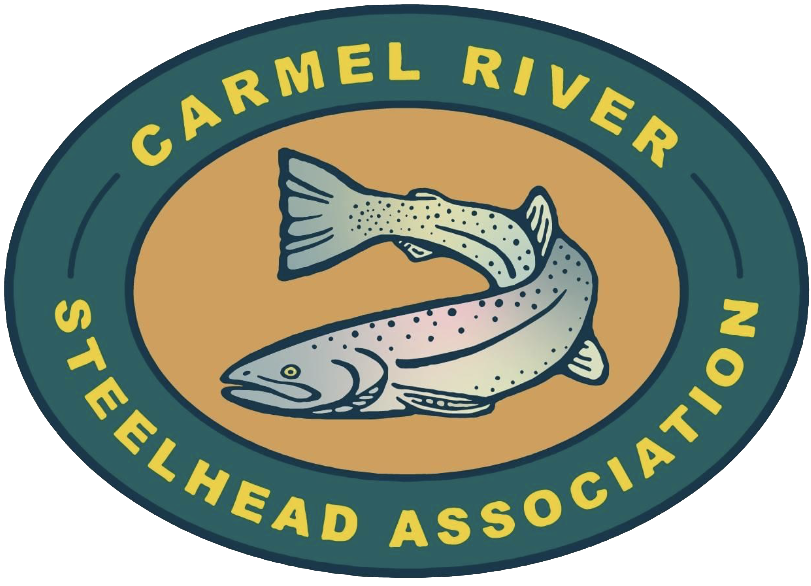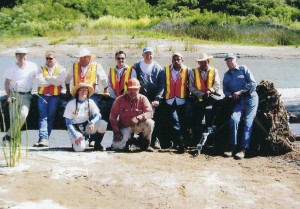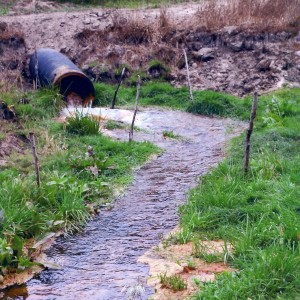In 1997 the Carmel River was listed as one of the ten most endangered rivers in the United States. There were many reasons for this listing including loss of habitat for steelhead. CRSA has worked for over forty years to rebuild habitat for steelhead and other species. Learn more about this program.
CRSA Gabion Project
The gabion project at Los Padres Dam was one of the first projects CRSA did with CA Dept. of Fish and Game. Mas Yokogua, who was president of CRSA at that time, visited the ladder and trap and saw a large number of Steelhead above the ladder and in the plunge pool below the dam. Mas inquired about fish transfers over the dam and found there had not been any recent ones.
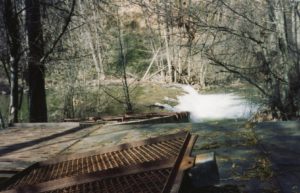
During that visit, Mas noticed that the entrance to the ladder was above the surface of the river, requiring fish to jump into the ladder. Even if a fish could jump into the ladder it was so full of debris it blocked upstream passage. CRSA offered to help DFG improve the trap by placing a very large rock gabion just upstream of the ladder to try to direct the fish to the ladder entrance. CRSA built, paid for and installed a stainless steel extension to the ladder so the fish did not have to jump into the ladder entrance and a cover over the lower part of the ladder so it would not fill with debris.
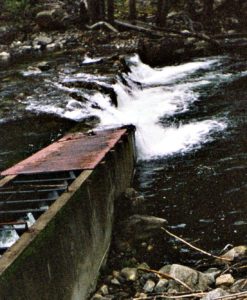
While it took CRSA several seasons to complete the gabion project it only took one large flood event to wash it away. Even so, the extension and the lower ladder cover made the ladder work much better than it did before.

Extending Los Padres Dam Spillway
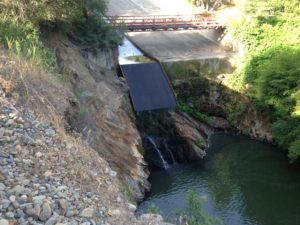 |
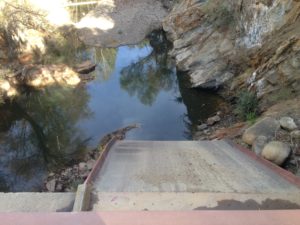 |
When Los Padres dam was built the only way for fish to migrate out of the dam and downstream was over the lip of the dam and down the concrete spillway. Unfortunately no one thought about fish when the spillway was ended 40 feet directly above solid rocks. This, of course, was not good for steelhead survival.
On one of the work days for the gabion project the CRSA contact from CDFW, Randy Bentine, was helping with the project when everyone noticed the river was full of mud and dead fish. Cal Am had drained the dam to work on the bottom valve. Bentine estimated the fish loss was about 250,000 small steelhead. Because of this event, and the fact it was noticed by CRSA and CDFW, Cal-Am was required to build a spillway extension to mitigate for the loss of the fish.
The metal extension is still visible today. If you are standing on the bridge over the end of the Los Padres Dam spillway look downstream and you can see the extension that has saved countless steelhead. When doing so think of what a small group of dedicated individuals can do to help.
Notching Los Padres Dam Spillway Lip
Shortly after CRSA was successful in extending the spillway at Los Padres Dam we began advocating for cutting a notch in the top lip of the dam. The problem was that when water was low fish would pass over the whole width of the dam and because the water was not concentrated, the shallow water would cause the fish to tumble unnecessarily down the spillway. When water was very low fish could not even get over the lip and were stranded in Los Padres Reservoir for the year. CRSA felt that if a notch were cut on the east side of the spillway it would provide a deeper exit over the lip to allow late fish to exit and deeper water to prevent tumbling down the concrete.
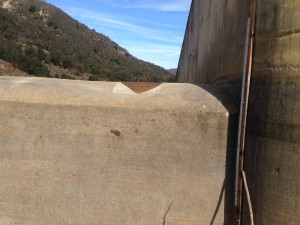 CRSA was able to talk the California Department of Fish and Game into cutting the notch which CRSA believes helped. There was opposition to the notch due to the concern that cutting a six-inch notch would lower the level of Los Padres Dam by six inches. CRSA felt that the water leaving the reservoir via the six-inch notch was no different than what was released by piping and that the exit through the pipe could be shut off until the water level was below the notch.
CRSA was able to talk the California Department of Fish and Game into cutting the notch which CRSA believes helped. There was opposition to the notch due to the concern that cutting a six-inch notch would lower the level of Los Padres Dam by six inches. CRSA felt that the water leaving the reservoir via the six-inch notch was no different than what was released by piping and that the exit through the pipe could be shut off until the water level was below the notch.
Later, when CRSA tried to get the notch deepened, it was instead filled in either from miscommunication or by design. With the notch open for such a short period of time there was never a test to determine if it saved the lives of fish, but logic says it did.
CRSA continued to advocate for the notch until 2008 when serious talks began to provide state-of-the-art downstream passage for steelhead.
CRSA was able to talk the California Department of Fish and Game into cutting the notch which CRSA believes helped. There was opposition to the notch due to the concern that cutting a six-inch notch would lower the level of Los Padres Dam by six inches. CRSA felt that the water leaving the reservoir via the six-inch notch was no different than what was released by piping and that the exit through the pipe could be shut off until the water level was below the notch.
Later, when CRSA tried to get the notch deepened, it was instead filled in either from miscommunication or by design. With the notch open for such a short period of time there was never a test to determine if it saved the lives of fish, but logic says it did.
CRSA continued to advocate for the notch until 2008 when serious talks began to provide state-of-the-art downstream passage for steelhead.
Removing Los Padres Dam Spillway Boulders
Although CRSA was successful in getting an extension to the spillway at Los Padres Dam, when the actual extension was complete the downward angle of the extension only partially pushed fish beyond the bedrock ledge.
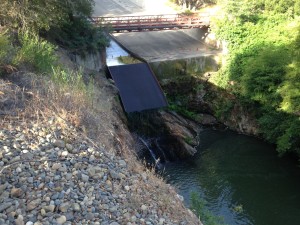 CRSA continued to lobby and complain about fish dying as they exited the dam, tumbling down the concrete spillway and crashing onto boulders at the base of the spillway. In August of 1995 CRSA convinced the California Department of Fish and Game to blow up the boulders in question.
CRSA continued to lobby and complain about fish dying as they exited the dam, tumbling down the concrete spillway and crashing onto boulders at the base of the spillway. In August of 1995 CRSA convinced the California Department of Fish and Game to blow up the boulders in question.
Fish and Game employees used thirty-five charges of dynamite in three sets to blow up the bedrock boulders. Approximately fifteen cubic yards of the bedrock was demolished, but Fish and Game decided it was unsafe at that time to remove the resulting small boulders. Shortly after the demolition a large storm event moved the boulders downstream and out of the way of fish.
As required in their Water Allocation EIR, the Monterey Peninsula Water Management District conducted tests to determine how successful the demolition was. For their test the District captured smolts in the river above the dam and in the river below the dam and used these fish to determine injuries from passing down the spillway and falling into the plunge pool. Although a small number of fish were used in the test the District determined only four percent of fish were injured passing over the dam.
Building Ladder and Trap
Considering that National Marine Fisheries Service considers 50% of steelhead habitat to be above Los Padres Dam, in 1999 CRSA decided it was time to do something. With a grant from the National Fish and Wildlife Foundation and with help from the California Department of Fish and Game and California American Water, CRSA began construction of better fish ladder and trap.
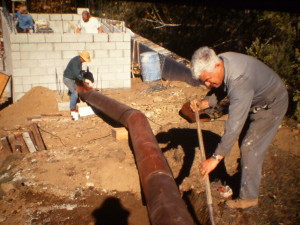
Piping into holding tank
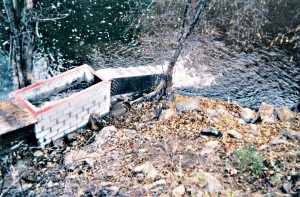
Ladder from river and first step pool
While CRSA volunteers contributed over 1,000 hours of labor, many others contributed materials and services at low or no cost including Howard Carter Associates, Monterey Peninsula Engineers, Wermuth Allied Van Lines, M. J. Murphy Lumber, and the County of Monterey which waved building permit fees, to make the ladder a reality. In the end, the total cost of the 70-foot ladder and holding tank building was only $107,750. Without volunteers and contributions the cost would have exceeded $250,000.
The new ladder and trap is a much better solution to the ongoing problem of upstream migration. The unique ladder design allows steelhead to swim up the ladder through two resting area pools and into a concrete block holding tank. Once in the holding tank they are encouraged to swim into the Cal Am transfer truck and then driven over the dam and released. All of this is accomplished without being touched by human hands.
The next time you hike to Los Padres Dam look downstream when you pass over the bridge at the end of the spillway. On the west side of the river you can see the CRSA ladder and trap which continues to help steelhead migrate to their ancestral spawning grounds.
Large Woody Debris, Phase I
It is well known that large wood in a river or lagoon provides protection from avian predators, affords daytime protection from solar radiation and offers considerable benefits to the ecosystem food chain. While some bankside cover would have developed naturally, large wood and structures in the center of the lagoon had no way of being recruited. Considering the Carmel River Lagoon is the most important habitat in the lifecycle of Carmel River steelhead, it was at least beneficial if not imperative that this newly created habitat be as good as possible as soon as possible.
With the pledge of $25,280.00 in matching funds CRSA was able to obtain a grant of $6,540.00 from NOAA Restoration Center and additional federal funding of $1,200.00. This money was used to create six large woody debris structures strategically placed in the south arm. Each structure created 200 square feet of overhead cover for steelhead, or 1,200 square feet in total. The structures were placed so they would each provide a 100-foot radius of “burst speed” protection from avian predators. (Burst speed is the maximum speed a small steelhead can achieve and 100 feet is the maximum distance small steelhead can maintain that speed.) In all, the six structures allow steelhead to utilize 90,000 square feet of the lagoon free from danger.
Countless agencies, businesses, and individuals contributed to this project. None were more generous than Gary Paddock and his Carmel Valley Construction who donated over $55,000.00 of construction effort. If you want to see the original press release which listed everyone who contributed click here.
Large Woody Debris Phase I Crew
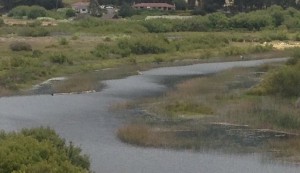
Large Woody Debris as it looks today
After two years of planning, engineering, and gathering of materials CRSA was ready to build and install the structures. In all, 22 large redwood root balls, 9 large 40-foot 3.5 foot diameter logs, 16 large swamp anchors, 4 swamp anchor extensions, 1500 feet of three-quarter inch galvanized cable, 40 tons of granite boulders and 250 cable clamps were used with the actual in-lagoon construction taking only 6.5 hours.
If you look at the south arm of the lagoon you can see the above water part of these structures and visualize what is under water. These six structures are working as well today as in 2006 when they were built.
Finch Creek Fish Passage Barrier Removal
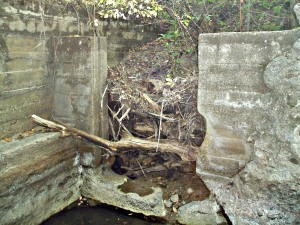
During fish rescues on Finch Creek, the main tributary of Cachagua Creek, CRSA members noticed an old dam that had become an obstacle for adult migration. The dam originally had a slot where flash boards could be inserted to hold back water and then removed to allow the creek to flow unobstructed. The dam had been abandoned for quite a while and the slot had become filled with debris creating a six foot jump for steelhead at low water or a three to four foot jump at high water.
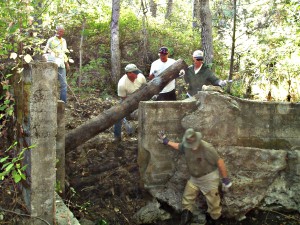
In 2009 after receiving permission from the landowner, seven members of CRSA using only hand tools removed the wood that blocked the slot and then removed most of the sediment that had filled in the small dam.
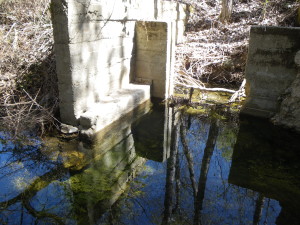
The end result was that CRSA not only removed a severe obstacle for upstream migration but created an excellent plunge pool and spawning area just below the old dam.
There are many other fish passage obstacles on most of the tributaries of the Carmel River and CRSA would like to see property owners and others work together to have them all removed.
Supplemental Water for the Lagoon
The Carmel River lagoon was once a prime steelhead lagoon, but partial filling in of the historic area of the lagoon for agriculture and housing along with over-pumping which robs the lagoon of fresh water in the summer and fall has created a lagoon that at best only partially provides what is needed to raise thousands of young steelhead.
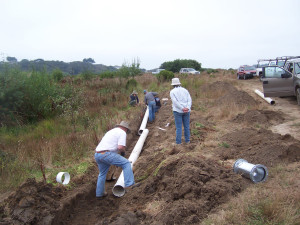
Replacing 60 feet of pipe
In August of 2008 CRSA noticed the level in the lagoon dropping to a critical low of just over 3 feet NGVD. Knowing that we had rescued over 14,700 fish from just the mainstem Carmel River, and knowing we had relocated a great many of these fish to the lagoon, something had to be done. CRSA contacted State Parks for permission to reactivate the well on the former Odello artichokes field to provide supplement fresh water to the lagoon.
Although the well had not pumped water for over 12 years and the agriculture field had been reworked to provide riparian habitat, CRSA decided it was worth the effort to get the well running and find the broken water lines.
At no charge to CRSA, California American Water sent two of their well experts to the Odello well and got the pump running again. A CRSA member brought his backhoe to the site for CRSA to use. During the following two weeks CRSA located and repaired a missing sixty foot section of water pipe and countless breaks in the line. After 380 hours of work by CRSA and State Park volunteers and $3,000.00, on August 28, 2008 approximately 500 gallons of cool fresh water per minute began flowing into the south arm of the lagoon. State Parks paid the electrical bill to run the well 24 hours a day until the river ran on February 16, 2009.
Well water running into lagoon
It would be impossible to determine just how much the supplemental water helped to save fish, but considering that in some past years most fish died because the lagoon had become anoxic CRSA firmly believes supplemental water in 2008 saved thousands of steelhead. An anecdotal effect of the pumping was that a day after the pump was turned on CRSA members noticed several Kelts nosing right into the fresh water stream entering the lagoon, reaping the benefit of fresh, cool, oxygenated water.
Helping Monterey Bay Salmon and Trout Project
 The Monterey Bay Salmon Trout Project (MBSTP) began two years after CRSA. Both organizations have the same goal but go about it in different ways and both organizations have helped each other.
The Monterey Bay Salmon Trout Project (MBSTP) began two years after CRSA. Both organizations have the same goal but go about it in different ways and both organizations have helped each other.
MBSTP has a hatchery on Big Creek in Santa Cruz County. When first constructed, CRSA volunteers helped build the raceways for their hatchery. It was these raceways that reared the steelhead from our Broodstock Program for return to the Carmel River. When we were finished rearing our steelhead, we donated the saltwater rearing tanks to the Monterey Bay Salmon and Trout Project.
MBSTP has a Salmon & Trout Education Program (STEP) where they train teachers (provided CDFW allows it) for two weekends in their curriculum. The teachers can then teach their students in rearing fertilized steelhead eggs to fingerlings. MBSTP provides the teachers with a cold water aquarium and at the end the students take a fieldtrip to the San Lorenzo River to release the fingerlings. CRSA feels this is a wonderful program and has paid the tuitions for multiple Monterey County teachers.
